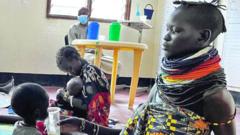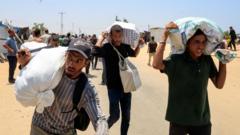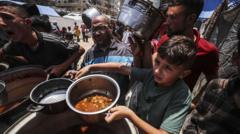Last month's earthquake in Myanmar has deeply affected the nation’s Buddhist clergy, resulting in numerous monk casualties as monasteries collapsed. The disaster comes on top of an ongoing humanitarian crisis, marking a significant blow to a prominent and revered aspect of Myanmar’s society.
Tragedy Strikes as Earthquake Devastates Myanmar’s Monastic Communities

Tragedy Strikes as Earthquake Devastates Myanmar’s Monastic Communities
A powerful earthquake in Myanmar has claimed thousands of lives, including many Buddhist monks, disrupting the spiritual fabric of the nation and leaving communities grappling with loss and recovery.
In late March, Myanmar faced a catastrophic earthquake that wreaked havoc across the nation, particularly impacting its monastic communities. One of the devastating moments occurred at the Old Masoeyein monastery in Mandalay, where numerous monks lost their lives beneath the rubble. Among the bereaved was Ashin Javanar Linkhara, who expressed sorrow while paying his respects to his deceased colleague, Ashin Pyinnyar Tharmi, a monk aged 27.
The attending monks performed rites typically reserved for deceased members of the clergy, yet the urgency of the disaster led to abbreviated ceremonies. Following the earthquake, which resulted in thousands of fatalities, the toll on the monks was significant, further complicating a country already embroiled in a humanitarian crisis due to ongoing civil conflict.
Buddhism in Myanmar, where about 90% of the population practices the faith, plays a crucial role in shaping national identity and moral standards. However, the recent emergence of extremist factions within the Buddhist community has resulted in violence against minority groups, particularly Muslims. This juxtaposition between spirituality and nationalism has been starkly highlighted in the wake of the earthquake, especially as communities come to terms with their losses and the preservation of their cultural identity is called into question.
As Myanmar begins its recovery process, the community is faced with rebuilding its societal structures, which have been irrevocably altered by this natural disaster and the enduring tensions exacerbated by civil unrest.
The attending monks performed rites typically reserved for deceased members of the clergy, yet the urgency of the disaster led to abbreviated ceremonies. Following the earthquake, which resulted in thousands of fatalities, the toll on the monks was significant, further complicating a country already embroiled in a humanitarian crisis due to ongoing civil conflict.
Buddhism in Myanmar, where about 90% of the population practices the faith, plays a crucial role in shaping national identity and moral standards. However, the recent emergence of extremist factions within the Buddhist community has resulted in violence against minority groups, particularly Muslims. This juxtaposition between spirituality and nationalism has been starkly highlighted in the wake of the earthquake, especially as communities come to terms with their losses and the preservation of their cultural identity is called into question.
As Myanmar begins its recovery process, the community is faced with rebuilding its societal structures, which have been irrevocably altered by this natural disaster and the enduring tensions exacerbated by civil unrest.



















